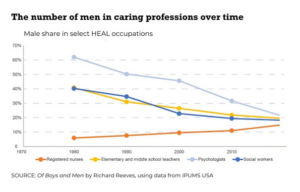By Elizabeth Heubeck — Education Week
The nursing and teaching professions have a lot in common. They both fall under the HEAL umbrella: health, education, administration, and literacy. People who enter these two fields tend to be motivated by a desire to become a force of good in the world. And, historically, both professions have been dominated by women.
But that’s changing, at least among one of these professions.
Over the last several years, the percentage of male registered nurses in the United States has ticked up considerably―from 2.7 percent of the total workforce in 1980 to 11.2 percent in 2022, according to the American Association of Colleges of Nursing―but the opposite has happened among the nation’s K-12 teaching workforce. About 33 percent of teachers were men in 1980; by the 2020-21 academic year, just 23 percent were, according to the National Center for Education Statistics.
Yet research shows that male teachers have many beneficial effects on student engagement. All students, but boys in particular, benefit from having a male role model in the classroom.
Why have more men been drawn to the nursing profession in recent years, and are there lessons schools and districts can glean from this other HEAL profession? To find out, Education Week spoke to males at every stage of the nursing profession—from young male nursing students to nurses with decades in the profession.
Read on for three insights that could inform recruitment strategies in K-12 education.

There’s less of a stigma about men in nursing
These days, there’s a decreasing stigma associated with entering a predominantly female profession like nursing, male nurses said. That stigma had weighed heavily on Frankie Hamilton when, in his early 20s, he considered switching professions from teaching high school chemistry to becoming a nurse.
“Right out of undergraduate school, in 2004, I was working with nurses a lot of the time, but every nurse I worked with was female,” said Hamilton, a board member for the American Association of Men in Nursing, an advocacy organization for male nurses. “I was like, everyone thinks nursing is just for women.”
Hamilton enrolled in nursing school in his late 20s. During his early career as a bedside nurse, he recalled encountering gender stereotypes on the job.
“When I would go into patients’ rooms, they would often say things like, ‘Why don’t you become a doctor?’” said Hamilton, currently the director of ambulatory care services at Lincoln Hospital in the Bronx neighborhood of New York.
“I feel like that’s probably less so the conversation these days,” he said. “There’s still that perception out there, but I think it’s diminishing.”
The declining stigma around male nurses could be in part a byproduct of changing societal perceptions of gender roles in general, as well as those specific to nursing, which COVID-19 helped to dissolve, experts say.
“I think a lot of media attention about the positive impact of nurses during COVID helped with that [evolving] perspective,” said Melissa Gomes, associate professor of nursing and associate dean for diversity, equity and inclusion at University of Virginia’s School of Nursin
Nurses were publicly hailed as “heroes” for their work during the pandemic, Gomes said.
“I think that the lens of what it means to be a nurse has shifted,” she said. But there’s more behind this shifting perspective than a chance global pandemic.
Nurses have opportunities for multiple career pathways
Advocacy organizations and nursing schools like UVA’s have intentionally worked to broaden the perception of nursing.
“We’ve done a great job in the profession of highlighting the nursing science and the impact that we as nurses have, across not only the clinical sector, but also with evidence-based, community-participatory research,” Gomes said.
It’s a tactic that’s appealing to men who are looking for a career that offers room for advancement. Such is the case for Jack Dennis and Ariel Till, both 20-year-old, 3rd year students in UVA’s School of Nursing program.
“I always knew I wanted to be in the medical field,” said Dennis, whose sister is a nurse. “There are so many pathways to nursing. It doesn’t stop at bedside nursing. You can go to graduate school, you can be an educator, you can be a nurse practitioner or a nurse anesthetist—there’s no stop to it
Till, who grew up hearing stories about the profession from his mom, who was a nurse, said that background, plus his interest in medicine and anatomy, drew him to the field.
“There are so many different routes, you don’t feel like you’re stuck in one place,” Till said.
Seasoned nursing professionals agree.
“With nursing, you can change your specialty, and many do. We have a broad education, and then you can specialize,” said Sean DeGarmo, who has been a flight nurse, a critical care nurse, a nursing instructor, and now serves as the director of advanced practice initiatives and certification outreach for American Nurses Enterprise, an advocacy organization.
Teachers, on the other hand, have fewer career pathways in education available to them. If they don’t want to pursue positions in administration, which generally require additional education and training, they often remain in the classroom or leave the field altogether. It’s an issue that’s gaining more traction recently.
“If we can create career pathways for teachers to expand their impact and build more sustainable lives, we can retain teachers and create a stronger education system. Instead of leaving to become realtors or lawyers, teachers can create curriculum, work as education consultants, and coach other educators,” wrote Lily Jones, a teacher advocate, in a January article on Forbes.com.
With more avenues for career advancements comes more opportunities for better pay. The average salaries of registered nurses and classroom teachers don’t differ too much. In 2023, federal data show the median annual wage for registered nurses was $86,070, compared to an average salary of $71,699 for teachers, who generally work on a 10-month contract.
But nursing professionals with advanced credentials tend to have higher pay ceilings than educators. For instance, the average 2023 salary for a certified registered nurse anesthetist (who need a doctoral degree) was $212,650, compared to $156,468 for K-12 superintendents, most of whom hold doctoral degrees.
There are strong advocacy efforts within nursing to recruit more men
Well before advancing through the career ladder, men must first feel comfortable with the notion of joining the nursing profession. That’s where advocacy efforts come into play.
The University of Virginia’s School of Nursing earned a “Best School for Men in Nursing” designation the past two years by the American Association for Men in Nursing.
Gomes credits the school’s MAN Club, a student affinity group that stands for Men Advancing Nursing, as part of the appeal.
“They have their own space where they can feel like, ‘Oh, OK, I see this is where I belong,’” she said
It’s where Till and Dennis first gained their footing as male nursing students, and where they now serve as leaders in the club.
“We’ve been visiting middle schools and high schools and really trying to kind of get the conversation going early, so that young [male] children and kids in high school can know that, ‘Hey, nursing can be a profession for me,’” said Hamilton, the association’s board member.
Hamilton sees a lot of parallels to effectively recruiting men for either teaching or nursing. Men first need to be educated on the traits that make up an effective nurse (or teacher), he said, and to consider whether their own strengths match.
“If your top qualities align with the qualities of a great teacher or a great nurse,” Hamilton said, “then it makes sense that this profession would be a possibility for you.”
February 04, 2025

